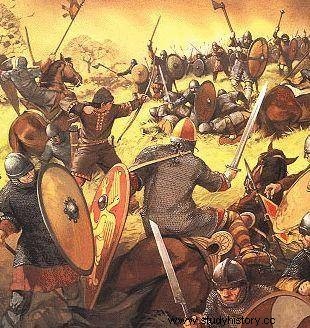
The Battle of Brunanburh saw the victory of King Athelstan and his brother Edmund over the combined armies of Olaf Gothfrithson, the Viking King of Dublin, Constantine II of Scotland and Owen of Strathclyde. Some sources also mention Irish and even Welsh mercenaries.
Primary sources
Primary sources regarding the battle are the Anglo-Saxon poem of the same name included in the Anglo-Saxon Chronicle, the texts of the Anglo-Norman historian William of Malmesbury, those of Simeon of Durham, the Annals of Tigernach, the Brut y Tywysogion and the Icelandic sagas such as the saga of Egill Skallagrímsson, who fought for Athelstan.
Context
King Athelstan had invaded the kingdom of Strathclyde a few years earlier (presumably around 933-934), angering other rulers of the British Isles, who feared for their own kingdoms.
This battle is considered one of the bloodiest of that time. She saw the deaths of five English kings (other sources say Irish) and seven Celtic earls, and many Saxons were wounded, including two cousins of Athelstan, Alfric and Athelwin, as well as an important Saxon bishop. It seems that the West Saxons at one time deployed a cavalry charge, contradicting the popular belief that the armies of the ancient English were based on infantry. Cavalry was still a relatively insignificant part of the Saxon army, and may have consisted of mercenaries from other kingdoms.
This is an important battle in British history:Athelstan's crushing victory irretrievably confirmed that England was an Anglo-Saxon kingdom, forcing the Celtic kingdoms to consolidate their positions.
The Battle of Brunanburh is still celebrated in the Wiltshire town of Malmesbury. Its inhabitants fought for Athelstan, and after the battle, it offered them 600 hides of land, as well as the status of free men, which has continued until today. When Athelstan died, his body was transported from Gloucester to Malmesbury, where he was buried.
In art
The English poet Alfred Tennyson translated the poem from the Anglo-Saxon Chronicle in 1880, publishing it in his Ballads and Other Poems. His son Hallam Tennyson published a prose translation of the poem. American composer Derek Strykowski used the battle as the basis for his Brunanburh Suite in 2005. Argentinian author Jorge Luis Borges wrote several poems about the Saxons and their victory at Brunanburh.
Site of the battle
The location of Brunanburh has not been identified with certainty. Several sites have been proposed in Northumberland, as well as Bromborough on the Wirral Peninsula, Burnswark in south-west Scotland, and Tinsley Wood near Sheffield in Yorkshire. These are not the only sites offered, but they are the most commonly accepted.
